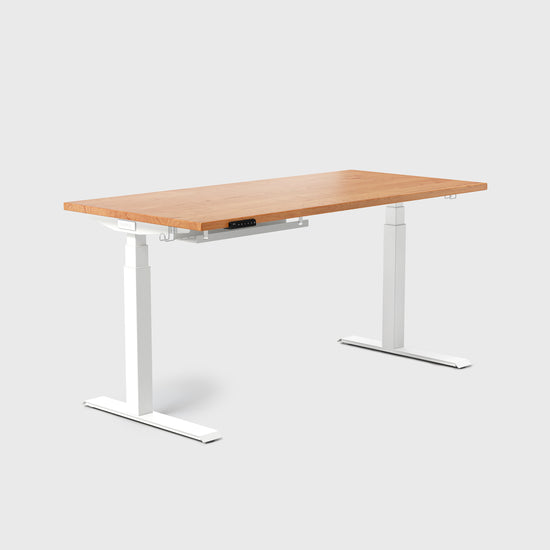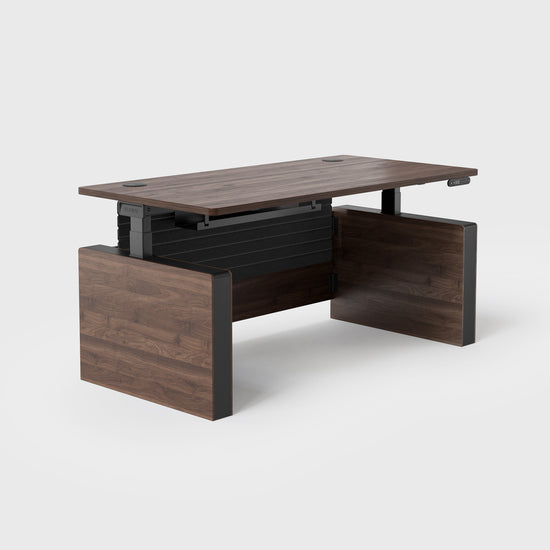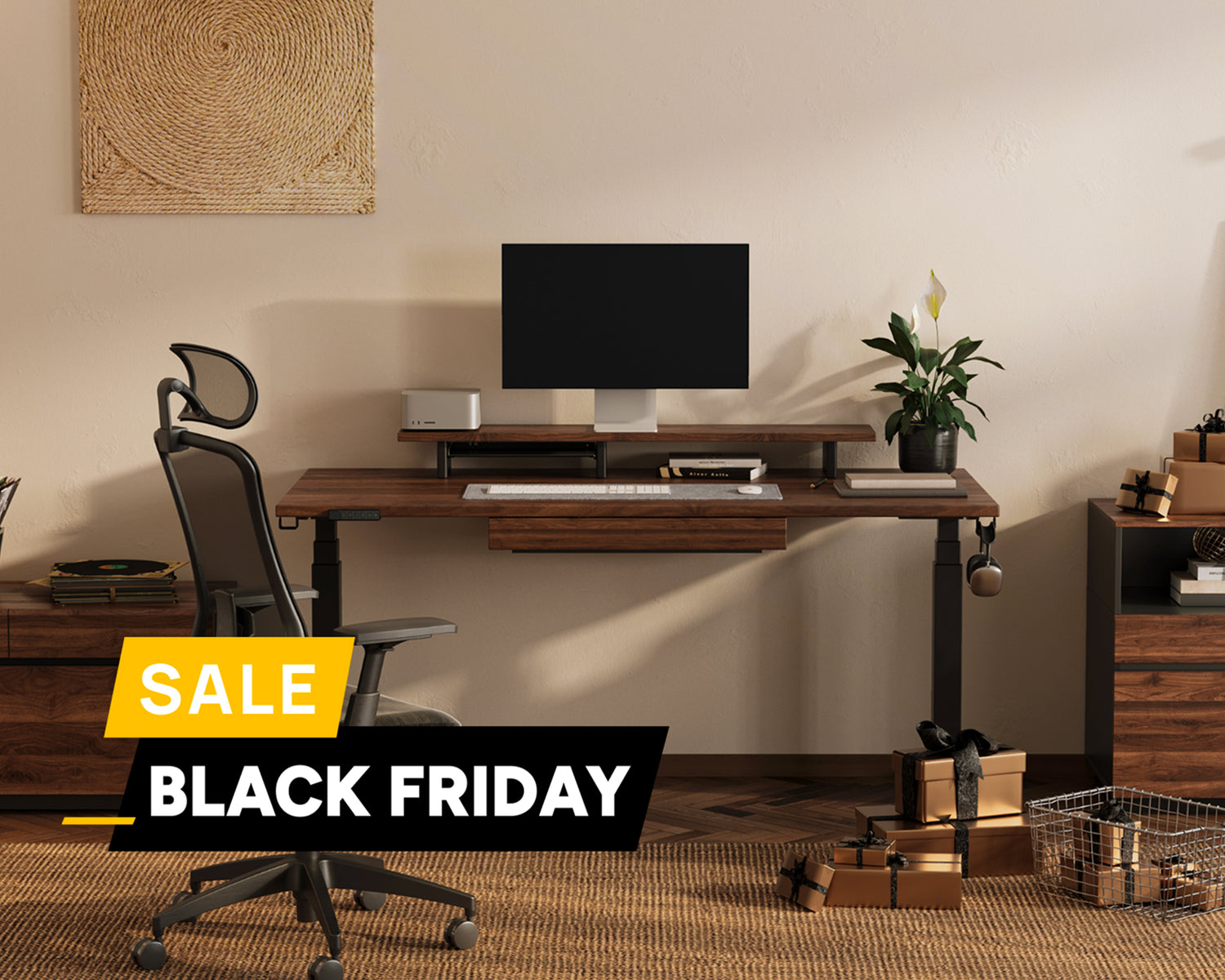Beyond the Myth
“Clear desk, clear mind.” It’s one of the most persistent ideas in productivity culture…but is it true?
It’s one of the most persistent ideas in workspace culture. But the truth is, our desks don’t just reflect our minds—they shape them.
A well-designed workspace does more than help us check emails or meet deadlines. It changes how we feel. It sets the emotional tone for our day. It can help us find calm, regain clarity, and step into deeper focus without forcing it.
In this article, we explore how the psychology of workspace design—from zoning and desk posture to lighting and personalisation—can help you build a studio that supports your state of mind, not just your to-do list. At the centre? A standing desk designed to anchor it all.
Your Workspace Is an Extension of You
Workspaces speak. Whether they’re filled with post-its and prototypes or empty except for a laptop and coaster, they communicate something about how we see ourselves and how we want others to see us.

The Psychology of Personal Space
Psychologists call this territoriality: the idea that we draw boundaries—physical or symbolic—around areas we identify as “ours.” Research shows that the more control we have over our space, the more engaged and motivated we feel in it. Personalising a desk, even with something as simple as a family photo or a quirky mug, enhances psychological ownership.
A University of Exeter study found that employees who could customise their workspace were up to 32% more productive than those in stripped-down environments. By making it feel like our space, we invest in a future, more-productive version of ourselves.
Actionable Tip: Curate, Don’t Clutter
Add 3–5 items that reflect your identity, values, or creative spark. These should be things that energise, not distract. It could be a plant, a piece of art, or even a personal mantra. Keep it intentional, not random. How do you want to feel when you sit down at your desk?
Make your workspace somewhere you want to return to every day. It should feel like a place where you are at your best.
Zones of Genius: How Layout Affects Mindset
Where you work within your workspace is just as important as what you work on.

Why Zoning Works
Try to group parts of your workspace into zones . There could be a space for messy ideation, one for deep focus, another for admin or recovery. Doing this is like building rooms for your brain to operate in. Dividing your space into different mental zones helps your brain switch gears more effectively.
In behavioral design, this is known as contextual cueing. When you enter a space associated with a specific task (for instance, standing to focus or sitting to reply to emails), your brain retrieves behaviours linked to that environment. This builds more consistent habits and reduces cognitive friction.
My Example: The 3-Zone Office
In my current studio, I mapped out zones not just based on tasks—but on how I wanted to feel while doing them. The space is relatively compact (about 12 square metres), so every part had to earn its place:
Zone 1: Stand + Focus
This is where my Vernal desk sits. It’s positioned to face a window but offset to reduce glare. This zone is for writing, editing, and taking calls using my laptop. All of these are high-focus tasks where I need the most screen space possible, where posture and energy matter.


Zone 2: Sit + Admin
To the side, I’ve added a compact filing cabinet with a side drawer system that acts as a seated workspace for lower-energy, more meditative work on my iPad. Tasks like sorting through email, scheduling tasks and sorting paperwork. The physical change in seating helps me downshift mentally.
Zone 3: Think + Recharge
At the back of the studio, there’s a low armchair and a small side table under soft lighting. I use this for reading, whiteboard sketching, or doing nothing in particular…which, oddly, often leads to breakthroughs.

This is what works best for me. Depending on how much space you have, your zones may look different, and might need to work for you in different ways depending on the tasks you need to get done. Each zone should signal a shift in posture, mindset, and energy.
Actionable Tip: Create Zones Intentionally
Even in small spaces, you can use light, angles or object placement to define zones. Don’t worry about making this Instagram perfect - think of it like switching mental gears every time you switch zones.
The Standing Desk as Your Command Center
The standing desk has become associated with modern productivity, but its real value lies in how it enables dynamic, movement-rich work environments.

Posture Shapes Performance
A standing position can boost alertness, reduce fatigue, and even improve executive function. It also burns calories. One study from Texas A&M University found that call center workers who used standing desks were 45% more productive than their seated peers after just a few weeks.
Contrary to some trends, the goal isn’t to stand all day. Prolonged standing brings its own problems. Instead, standing desks shine when they’re used intermittently, as part of a movement loop that encourages physical variation throughout your workday.
Actionable Tip: Stack Standing With Routine
Use standing periods as bookends for your most focused work blocks. Pair them with music changes, lighting, or even a drink to reinforce the habit loop.
The Myth of the Tidy Desk
“Messy desk, messy mind.” It’s catchy . It’s also, well… not quite the full story.

What the Research Really Says
A 2013 study led by Kathleen Vohs found that tidy environments encouraged healthy, conventional behavior, where participants made safer decisions and preferred classic products. But in a messy room, they were significantly more creative, choosing novel options and coming up with more original ideas. The theory behind this finding is that breaking the 'convention' of a super-clean desk gives the mind permission to break new ground and imagine new concepts, solve problems and think differently.
The takeaway? Mess isn’t always a bad thing. It depends on the task. Executional work may benefit from order. Exploratory, creative tasks might thrive in a bit of chaos.
Desk State = Work State
Rather than aiming for a constantly spotless desk, consider syncing your desk state to your desired mental state. Let it ebb and flow with your creative cycles. If you have creative work to do, don’t bow to the pressure of having to tidy up before your work is done, just lean in to the mess and ride the next creative wave.
Actionable Tip: Micro-Reset, Not Perma-Clean
Schedule small resets at the end of your week. Not to sterilise your space, but to prepare it for your next creative push.
Movement and Momentum: The Workspace-Mind Loop
We often underestimate the mental effects of physical change. Movement, however, is a neurological multiplier.
The Dynamic Workspace Advantage
Workspaces that support micro-movement (shifting weight, walking a few steps, changing posture) can help regulate emotion, boost mood, and fight the cognitive slump that comes with prolonged sitting.
According to research from the British Journal of Sports Medicine, breaking up sedentary time with standing or walking every 30 minutes improves metabolic and psychological outcomes.
Think With Your Body
Movement facilitates thought. Taking a step, looking around or rotating your shoulders mid-task can help dislodge mental blocks or refresh attention. A well-designed workspace enables that rhythm rather than restricts it.
Actionable Tip: Program Movement Into Layout
Place key objects (like your printer or whiteboard) just far enough that you have to stand or walk. If you can, do the same with your phone to avoid distraction. Set a timer to give you a 30min reminder that you need to change your state. Try and allow the whole space to make movement inevitable.
Designing for Focus, Flow, and Feel

Your workspace is something you touch, see, hear (and depending on how clean you keep it….something you might taste and smell too). A multi-sensory experience like this affects how you feel, whether you notice it or not.
Light, Color, and Clarity
- Lighting: Natural light boosts alertness. Warm lighting from a candle or desk lamp soothes. Mix both, depending on time of day.
- Color: Blues and greens enhance calm and concentration; yellow stimulates creative energy.
- Visual clutter: Too much can lead to cognitive overload. Aim for creating some visual breathing room.


Biophilic Boosts
A small plant on your desk does so much more than add a colour to your space. Multiple studies show indoor plants reduce stress and increase concentration. If you’re struggling to keep them alive, even having images of nature on your desktop has been shown to have a restorative effect on attention. I love these terrariums which are zero maintenance and still have a calming zen-llike effect whenever I look at them.


Actionable Tip: Conduct a Sensory Audit
Look at your space with fresh eyes. What feels good? What drains you? Adjust light sources, remove visual noise, add something living, and experiment with texture or scent.
Workspaces That Work
Remember, your workspace is more than just a nice desk. It’s a system, a living environment that directly influences the way you feel, the way you think, and the kind of work you produce.
It should reflect your identity, support your habits, and evolve with your energy. Whether you thrive in a clean, minimal flow or a slightly chaotic creative zone, what matters most is intention.
The Vernal standing desk is an incredible foundation. Build around it with purpose, playfulness, and self-awareness, and your workspace won’t just work. It will work for you.
Author Bio
Mark Gilroy:is a coach, consultant, and content creator who helps ambitious humans do better work without burning out (or zoning out). As the brain behind The Mind Giraffe, he blends psychology, tech, and real-world strategy to help people think clearly, work smarter, and build systems that actually stick.
By day, he coaches teams and leaders. By night, he moonlights as a YouTube technology nerd with too many keyboards and a knack for turning workspace obsessions into performance upgrades.
Find him at themindgiraffe.com or @thatmarkgilroy on the socials.

- Regular price
-
From
$899.99 - Regular price
-
$1,289.99 - Sale price
-
From
$899.99

- Regular price
-
From
$639.99 - Regular price
-
$899.99 - Sale price
-
From
$639.99



